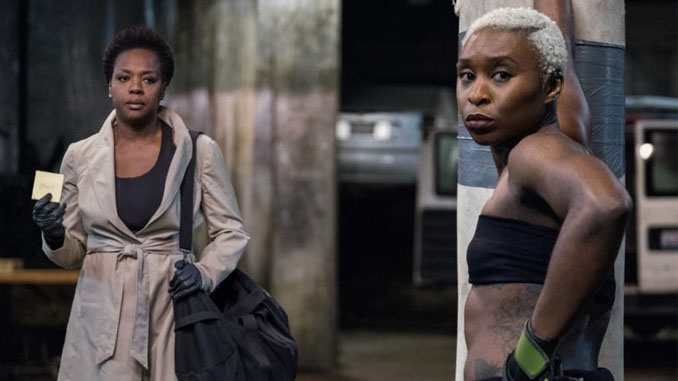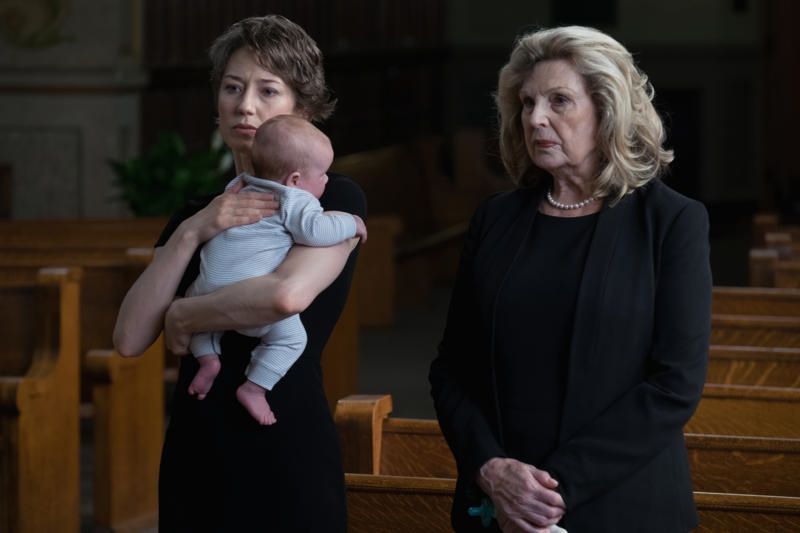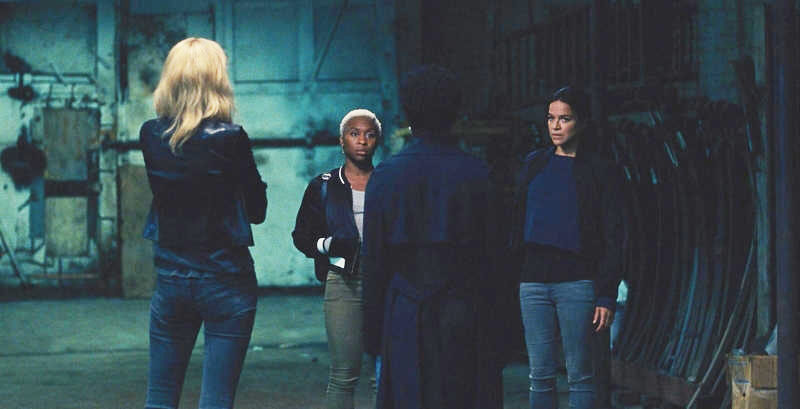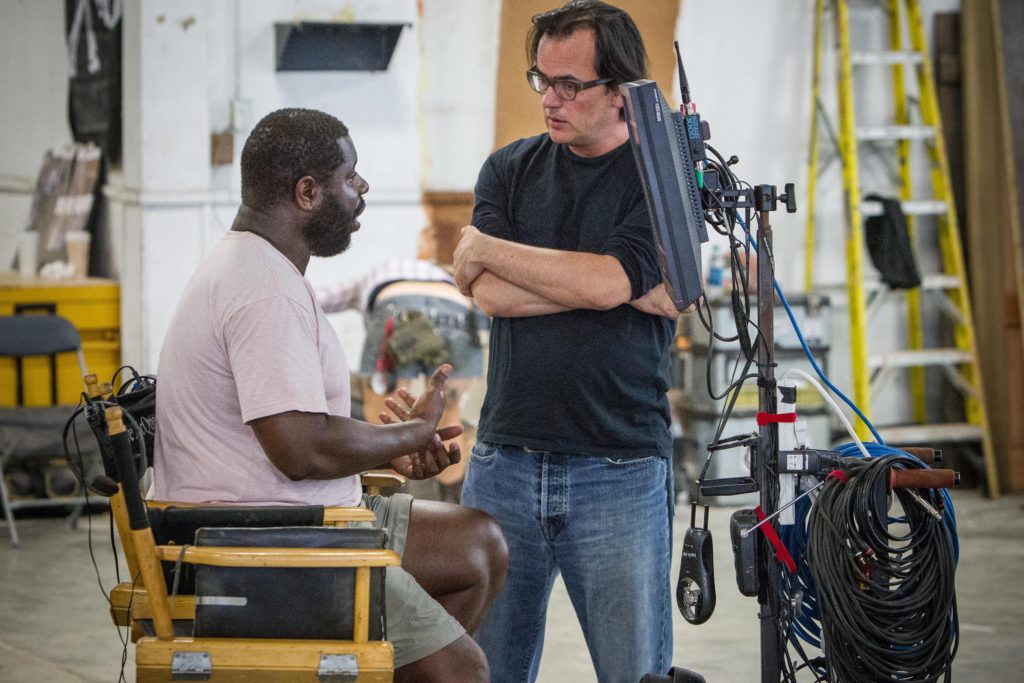
by Rob Feld • film stills courtesy of 20th Century Fox
As a teenager growing up in West London in the UK, Joe Walker, ACE, had two interests: music and film. He was in bands, wrote music and mucked about with his parents’ 8mm film gear. The availability of film education was minimal in 1981, however, so he pursued training as a classical composer. He wrote large orchestral pieces and a great deal of music for television, but quickly gravitated to the cutting room while trying to keep both careers afloat. With only so many hours in a day, however, editing won out.
Walker found a position as a trainee editor at the BBC’s film department at Ealing Studios, which gave him the opportunity to try his hand at comedy, documentary and drama — which is where he landed after deciding that the manic rhythm of news editing was not for him. He climbed the ladder at the BBC, first sound editing and then picture editing TV movies and miniseries. After branching into feature films in the mid-2000s, Walker partnered with Steve McQueen for the British director’s feature debut, Hunger (2008), marking the beginning of one of his most significant collaborations.

The new film Widows, which opens Friday, November 16 through 20th Century Fox, is the most recent result of their partnership, a feature film adaptation of Lynda La Plante’s 1983 Thames Television miniseries, set in London. Transposed to contemporary Chicago, the film tells the story of four women breaking type. When their spouses are killed in a failed heist, the widows share a debt left behind by their husbands’ criminal activities — and their creditor intends to collect. Thus cornered, the women embark on lives of crimes themselves.
It was a complex production to which Walker came later than usual, with only a weekend between completing Blade Runner 2049 (2017) with his other frequent collaborator, Denis Villeneuve. When the editor arrived, with his standard process of cutting while McQueen shot thus disrupted, he found Widows had a particularly large number of narrative elements to track for an audience, including over 80 speaking roles and 156 scenes shot in 70 locations. Whereas Walker describes their 2011 collaboration Shame as coming together very quickly, the shepherding of the ensemble cast of Widows provided many challenging months of editing before they had a cut of which they were proud.
CineMontage: Tell me about the unique training opportunity you had at the BBC, and how you were able to develop your career through it.
Joe Walker: I had two very influential mentors there. The first person who spotted my potential was an amazing editor, Pam Bosworth. She had whistled on the soundtrack of The Bridge on the River Kwai [1957]. She cut in white gloves and had a rigorous system; I would bring in dailies for her, rolls of film prepped on plastic trays stolen from the canteen. I’d leave a tray by her side, take the old tray away, reconstitute the trims and put everything away. That was my first proper taste of how a cutting room works.
Being a staff editor, there was no particular financial advantage to what kind of show you worked on. If you cut a drama, you’d be paid exactly the same as on a documentary. So, the thing that really impressed me about Pam was how she kept her feet in both camps. Her sensibility in one informed her work on the other — she was skilled at finding a narrative in documentary, and adept at weeding out anything that smelt fake in drama. Later, I worked with a magnificent editor called Ardan Fisher. He was the first who really showed me how to cut. He let me assemble sequences, gave me feedback, and encouraged me, even let me sit with the director and finesse things that I’d assembled. His thoughts on editing have permeated my career because he had a kind of certain perversion not to cut the way that everybody else does.

CM: How so?
JW: He let me cut a scene about three old men having an argument in the pub. The scene was covered by a wide shot and individual singles on each character. I spent the afternoon cutting frenetically away, trying to navigate between all the different takes to get the best readings, shoehorning in every reaction I could find. It was quite a busy cut. Arden took a look and said, “Yep, pretty good. Reconstitute the wide shot and let me have a look at it.” So, I joined the shot back together and he said, “Well… it’s better.”
Just because they shot it, doesn’t mean you have to use it. The body language between the three in the wide was plenty. I grew to recognize that approach in other films that influenced me, like Down by Law [1986]; at one point it had three characters stuck in a cell, and they just hold on the shot — a perfect frame surrounding all the dynamics between the characters. It invites the audience in, but doesn’t force them to a conclusion, instead letting them find what they want in a shot. It’s a huge lesson: when not to cut.
CM: How did your first collaboration with Steve McQueen come about, and how has your process of working together evolved?
JW: I had done work of which I was proud, but Hunger was the first film I edited that I felt was truly necessary as a film. I came from a Catholic family and growing up had a rather filtered view of what the Irish prison hunger strikers actually stood for. I felt it was the right time to see that history given a 360-degree view. I think it’s a very fair film. When I think back to 2007, though, it was me and Steve in a dingy basement; the English writer John William Polidori had killed himself in the 1820s in that basement. We had no assistant, an Avid with old SCSI drives that didn’t always work and very little time. Steve’s first art pieces were shot on 8mm, so he knows about economy — “waste not want not.” That helped make the editing process swift.

One of the ways we work that started on Hunger was benefiting from an built-in pause in the schedule. Actor Michael Fassbender had to lose a lot of weight so he went off to Venice beach and had two raisins a day for six weeks. We had three weeks in the can, so that gave us a gap before the final week of shooting. Steve and I had a chance to fine cut what had been shot and really revisit what was expected from the final week of filming. Nowadays, Steve factors in pickup shooting. That has been a big part of the editing process, of saying we actually need to go from A to D via X, rather than B and C.
CM: That’s kind of a rare opportunity. Not every editor gets the opportunity to offer input like that.
JW: Is there some sort of shame that you might not have wrenched film straight out of the camera and put it on the screen? You don’t want to denigrate your collaborators’ amazing work, but of course there’s a post-production process that helps make the story as successful as we’re trying to make it. And Widows is no exception. Plans adapt. There was a lot of re-engineering achieved in post, tested against audiences to fine-tune every detail, making them all point magnetic north.
CM: Do you like that process of audience testing?
JW: I love it. When you’re sitting with an audience, you know when things are working and when they’re not. It’s a great way of sifting out things that you may have pretensions about. Not unlike a heist, you have to case the joint to know how plans are going to play out in reality.
CM: Can you compare your collaborations between McQueen and Denis Villeneuve?
JW: They’re more alike than unalike. It’s the same rigorous editing process for both of them. I suppose one difference between them is that Steve doesn’t storyboard, and a crucial part of Denis’ preparation are his amazingly advanced storyboards. He has this fantastic collaborator, storyboard artist Sam Hudecki. On Sicario [2015], Arrival [2016] and Blade Runner 2049, they put the story through a huge conceptual workout; they created preliminary designs for the sets and props, and decided the weather systems — really investigating the ecology of a film. Denis pins the storyboards up on location, but just as soon departs from them when something better happens on set.
In comparison, Shame with Steve came together incredibly quickly. I recall about five weeks of filming and five weeks of fine cutting. Because it’s a simple story about one person and his sister.

CM: What was the particular storytelling challenge of Widows?
JW: Widows has a large ensemble: so many characters, so many ingredients that have to click into place. It pushes the Sudoku puzzle level from ‘medium’ to ‘evil.’ It was many months before we achieved what we were aiming for. It’s like the spinning-plate trick at the circus. The really expert performers do a wonderful job of letting one plate flop to the point where the tension’s almost too much. Then they come back at the last micro-second to give it a spin, only for another plate to look vulnerable.
It’s a fine balance. Veronica [Viola Davis] is the central character; her story is the spine of the film. But you can’t be too cursory with some of the other characters, who have their own very believable worlds to establish. For example, Lukas Haas’ character David — a businessman who relies on Sugar Daddy websites — there were moments so delicious that we had to protect that little extra space that allows you to look at him and be, against your instincts, a little won over by his charm. Everyone has his or her moment.
CM: How do you handle that?
JW: It’s trying to herd all these great things that the actors did into a flow. The character of Alice [Elizabeth Debicki] has a great trajectory, going from ditzy and passive to discovering her independence and a real talent for crime. You want to make sure that arc has its own clear momentum; you don’t want to short-change an essential step. Steve and [co-screenwriter] Gillian Flynn co-wrote an absolutely ripping yarn with phenomenal twists and turns; measuring the placement of those with an audience has been a really important part of our work. The reward was that when I sat with the film’s first major audience at the Toronto International Film Festival, there was a moment when several thousand people simultaneously gasped.
A lot of movies just play to their own audience, and our times are worryingly polarized. One thing I’m proud of is that Widows has such tremendous reach. Steve excels in a genre that all audiences can be thrilled by whilst examining some of the most relevant issues of our day. That it’s of-the-moment is all the more remarkable given the first I heard about Widows was back in 2012 when we were cutting 12 Years a Slave [2013].

CM: Is there a commonality you’ve found in the films you’ve done with McQueen?
JW: All of our films have given me an opportunity to play with time structures, which is an interesting part of Widows. At the beginning of Shame, there’s a pattern of little time loops where you’re not really sure whether it’s the same thing happening every day, or whether it’s one event looked at from different vantage points. I think we took playing with time to a really high level on Twelve Years a Slave. It was written as a sequential story that started with a free man being abducted into slavery, but we turned it inside out to start the film immersively in the slave experience and push the early years later, into flashback.
In Widows, some of what interested me was delving into Veronica’s past and the tragedy that’s at the heart of her character. You’ve got the classic thing of a heist movie, in which all the ingredients are slowly coming together and accelerating toward the big night. You’ve built all that momentum, but you’re also cross-cutting it with more poetic investigations of how the characters got to where they are — and we chose to reveal that non-linearly; it created suspense.
Steve and I are always looking for ways of playing with time. And I think most of my career can be attributed to a very simple editing trick: If you have a shot of somebody looking very thoughtful, you can cut to almost anything and suggest that’s what they’re thinking of. Arrival was often that.

CM: Do you rely on a lot of those tricks while editing?
JW: Well, to pull off a heist, you often need sleight of hand. One thing I’ve done is push hard on the collaboration with visual effects to help stitch together things to create new material. Javier Marcheselli, my visual effects editor, and I have been in neighboring rooms for more or less six years. A simple example in Twelve Years a Slave is where we had a wide shot of a slave cottage with Solomon and Eliza sitting on the veranda; it’s used in a scene showing an argument between them. But when Eliza is dragged away, we wanted to make the point that there’s nobody left on this plantation who really knows Solomon — even what his real name is. So we took that shot and reprised it, painting Eliza out. You get the sense of somebody missing, a negative space.
CM: How many visual effects shots were in that film?
JW: There were probably no more than 50 effects shots in that film. With Widows, the number of shots of that nature have probably crept up to two or three hundred. Maybe it’s a decent stitch between one side of a take and another, or using a passing vertical to mask a cut, or removing dialogue completely from a scene. Others are really audacious, but I can’t really tell you about them!
I heard a podcast the other day that was discussing an all-in-one shot in Twelve Years. They identified six invisible cuts. Actually, I didn’t make any of them. But they missed one big-normous invisible cut straight afterwards. So, I was proud of that. I like the art that hides the art. That’s the kind of magic trick in editing that I love.






